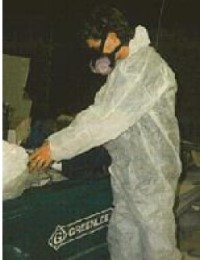

Identifying
and Controlling Hazards
Course 101
Safety Certified Supervisor Series
MODULE FIVE: CONTROLLING HAZARDS
Management Controls
Personal Protective Equipment (PPE)
 Using
personal protective equipment is a very important safe work practice. It's
important to remember that, like other management controls, the use of PPE
does not control the hazard itself, but rather it merely controls exposure
to the hazard by setting up a barrier between the employee and the hazard.
Using
personal protective equipment is a very important safe work practice. It's
important to remember that, like other management controls, the use of PPE
does not control the hazard itself, but rather it merely controls exposure
to the hazard by setting up a barrier between the employee and the hazard.
Use of PPE may also be appropriate
for controlling hazards while engineering controls are being installed or
work practices developed.
PPE Drawbacks
The limitations and drawbacks of safe work practices also apply to PPE. Employees need training in why the PPE is necessary and how to use and maintain it.
It also is important to understand that PPE is designed for specific functions and are not suitable in all situations. For example, no one type of glove or apron will protect against all solvents. To pick the appropriate glove or apron, you should refer to recommendations on the material safety data sheets of the chemicals you are using.
Your employees need positive reinforcement and fair, consistent enforcement
of the rules governing PPE use. Some employees may resist wearing PPE according
to the rules, because some PPE is uncomfortable and puts additional stress
on employees, making it unpleasant or difficult for them to work safely. This
is a significant drawback, particularly where heat stress is already a factor
in the work environment. An ill-fitting or improperly selected respirator
is particularly hazardous, since respirators are used only where other feasible
controls have failed to eliminate a hazard.